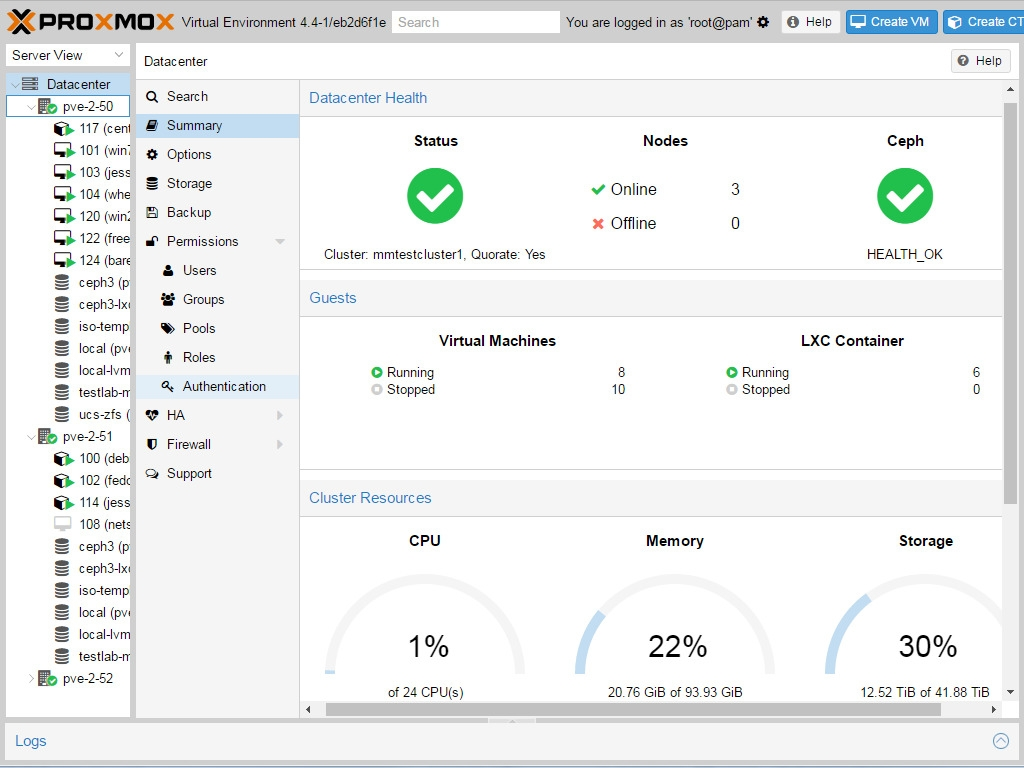Either self-hosted or cloud, I assume many of you keep a server around for personal things. And I’m curious about the cool stuff you’ve got running on your personal servers.
What services do you host? Any unique stuff? Do you interact with it through ssh, termux, web server?
This might be a better question for !selfhosted
I have an orangepi zero 3 with pihole
Then an ITX PC with
-
mealie (meal planner, recipe parser, grocery list maker with a bunch of features and tools)
-
immich for self hosting a google photos alternative
-
*arr stack for torrenting Linux ISOs
-
Jellyfin for LAN media playing
-
home assistant for my VW car, our main hanging renovation lights, smoke and CO monitors, and in the future, all of the KNX smart systems in our house
-
Syncthing for syncing photo backup and music library with phone
-
Bookstack for a wiki, todos, journal, etc… (Because I didn’t want to install better services for journals when I don’t use it much)
-
paperless-ngx for documents
-
leantime for managing my personal projects, tasks, and timing
-
Valheim game server
-
Calibre-web for my eBook library backup
-
I had nextcloud but it completely broke on an update and I can’t even see the login fields anymore, it just loads forever until it takes down my network and server, so I ditched it since I never used it anyway
-
crowdsec for much better (preemptive) security than fail2ban
-
traefik for reverse proxy
As a person that actually torrented a Linux iso on Friday, thank you! Lol
-
Minetest server, arr suite, plex, Pihole, calibre, homesssistant, Nextcloud.
Interact with it through a Homarr webpage and all of it is virtualized through proxmox.
I’ve been a software engineer for 8 years and I’ve had my own Jellyfin server (and before that, Plex) set up for 4 years on a server that I built myself.
Despite this, I don’t have a damn clue what “virtualized through Proxmox” means any time I read it.
They are just running things in VMs. They may even have a cluster with some sort of high availability.

Or containers, but lxc instead of docker-like. They’re like full VMs in operation but super lightweight. Perfect for some needs.
I personally find that LXC really isn’t better than a VM.
U crazy! lxc is incredibly lightweight compared to a vm, I’m often amazed at what it can do with just a few hundred MB of memory.
Also you can map storage straight from the host and increase allocation instantly, if needed. Snapshotting and replication are faster too.
I’m always bummed when I’m forced to run a VM, they seem archaic vs PVE CTs. Obviously there are still things VMs are required for, though.
Proxmox is a hypervisor, like VMware. They are just running containers and / or VMs. Procmox is the management interface.
You use Homarr with Proxmox? I should look into that.
Ya I have it running as an LXC. Here’s a script you can run in your proxmox shell that will create it for you:
bash -c “$(wget -qLO - https://github.com/tteck/Proxmox/raw/main/ct/homarr.sh)”
Lenovo ThinkStation P330 Tiny. Debian + Podman systemd quadlets, running these services:
- Jellyfin
- Sonarr
- Radarr
- Qbittorrent w/ VPN
- Linkwarden
- Calibre Web
- Immich
- Lidare
- Postgres
- Prowlarr
- Vaultwarden
P330 tiny is so good I just wish there was a ryzen version with a pcie slot. Quicksync is great but I hate Intel.
Do you have any tips (or examples) using quadlets? I tried using them but I couldn’t wrap my head around them.
I used this guide https://www.redhat.com/sysadmin/quadlet-podman
I have a folder on my in my home folder called
containerssymlinked to/etc/containers/systemdwith my .container files. This is my jellyfin.container for using the Nvidia Quadro on my server.[Unit] Description=Podman - Jellyfin Wants=network-online.target After=network-online.target Requires=nvidia-ctk-generate.service After=nvidia-ctk-generate.service [Container] Image=lscr.io/linuxserver/jellyfin:latest AutoUpdate=registry ContainerName=jellyfin Environment=PUID=1000 Environment=PGID=100 Environment=TZ=America/St_Johns Environment=DOCKER_MODS=ghcr.io/gilbn/theme.park:jellyfin Environment=TP_THEME=dracula Volume=/home/eric/services/jellyfin:/config Volume=/home/eric/movies:/movies Volume=/home/eric/tv:/tv Volume=/home/eric/music:/music PublishPort=8096:8096 PublishPort=8920:8920 PublishPort=7359:7359/udp PublishPort=1900:1900/udp AddDevice=nvidia.com/gpu=all SecurityLabelDisable=true [Service] Restart=always TimeoutStartSec=900 [Install] WantedBy=default.targetI use
sudo podman auto-updateto update the images to utilize theAutoUpdate=registryoption.
countless “read later” pdfs …and cat pictures
Cat pictures ? Definitely the best possible use of a server 😄
Self-hosted machine. It was basically my old computer I bought back in '09. It’s a i5-750 on a Asus P5P77. It started with the 4 GB RAM I hadn’t sold until I upgrade to 8. I used a borrowed Nvidia GT730 and a 1 TB HDD at first until I upgrade my main PC GPU and bought a new HDD for the server so now it runs in a 4 TB HDD and my old GTX 1060 3 Gb. It’s a beast for my needs.
-
Jellyfin is the main reason I started my server. Initially it was so my mother could easily watch shows I would never illegally download. Until a realized it would be great for me too and friends. To not watch them…I mean, because that would be ilegal!
-
Qbittorrent…shit…oh well :)
-
Nginx, when I realized I could host my own development server and personal website
-
Komga, when I realized I could have the same benefits of Jellyfin with books and comics.
-
Tailscale, allows me to, among other things, use it as an online or LAN hard drive for me and people I like.
-
Samba, see above. It also works to keep a nice share folder between my main PC and my laptop
The more time passes the more I realize self-hosting is the best idea ever. I get new ideias every day.
-
I settled on a Fujitsu Q920 with 16 GB of RAM and a 1 TB SSD. Runs FreeBSD 14.1 and each service has its own Jail.
Services:
DNSmasq - local DNS and adblocker Wireguard Navidrome MPD - Media server Vaultwarden - password save Radicale - cardav and caldav server TinyRSS - RSS aggregator Zabbix - server and service monitoring Postgresql Gitea - git repository Emby - jellyfin alternative Mariadb Bhyve VM with Debian running 2 apps (invoiceplane and leantime) which use a quite old php version and I never had time to port to Freebsd.
A second machine that starts daily and creates a backup of machine 1 by using ZFS autobackup.
Nothing fancy but it does what I need.
- Prosody XMPP server (might move to ejabberd) with Movim front-end
- Murmur VoIP server
- Miniflux feed reader
- Nix remote builder & substitutor
- Upterm terminal sharing
- Some small static sites on Nginx
- Darcs, Pijul, Git hosting (no forge, basic SSH + HTTPS)
Nothing yet, I’m still trying to figure out how to get my orange pi working… not much progress yet because I am just starting and making a server is very intimidating 😅 For now I’d like to just get it working so I can access a hard drive, and if I manage that and feel very daring, then pihole, jellyfin and home assistant.
Have you tried DietPi?
Pi-hole DNS and dhcp + home assistant and a bunch of other related containers.
Two old HP thin client PCs configured as 4TB SFTP file servers using vsftpd on Debian. Each one uses software RAID 1 with both an NVMe and SATA SSD internally, and are in two separate locations with a cron job which syncs one to the other every 24 hours.
People who actually know what they are doing will probably find this silly, but I had fun and learned a lot setting it up.
tell me about the cron thing. im thinking of doing just that on mine for backup.
are you scping them together?
I am using lftp and mirror. One server functions as the “main” server, which mirrors the backup server to itself once per day at a specific time (they both run 24/7 so I set it to run very early in the morning when it is unlikely to be accessed).
In my crontab I have:
# * * * /usr/bin/lftp -e "mirror -eRv [folder path on main server] [folder path on backup server]; quit;" sftp://[user]@[address of backup server]:[port number]til about lftp. i’m gonna be testing that one out thanks
No problem! Glad I could be of help, and best of luck on your project.
If it works reliably who cares?
here is my deploy
Are you using Kavita for your books as well? I have my books on Calibre, but I’m seriously considering putting it all under Kavita.
yes i use kavita, i have a couple hundred books.
I guess that’s going to be the way. I’m moving all the services I have under UnRaid to ProxMox, and wanted to lower the app count. Thanks for the tip.
On an orangepi5, managed via webUIs and SSH: -Home Assistant and associated programs (notably zigbee2mqtt and nodered) -Pihole
8TB Unraid NAS managed via Unraid’s webui -Whooole *arr stack -Jellyfin -Mealie
Thinking about nextcloud for the next one.
-Jellyfin: for playing media that I totally own and surely did no obtain by any obscure way.
-Qbittorrent: for reasons completely unrelated to the previous one.
-Amule: see above.
-Synapse (matrix server): overly complex way to send myself notifications from the server to my phone.
-FreshRSS: to have a self hosted RSS feed server. Could I use an android app for the same thing? Sure. But it’s more fun and headache inducing this way.
-TubeArchivist: Because I want to offload some of that cost inducing bandwidth that is making those poor YouTube executives to keep pushing more aggressive ads on their platform. I’m just that nice.
-Caddy: because I’m just lazy.
-Crowdsec: Because I’m just paranoid.
On my Raspberry Pi 4 4gb with encrypted sd is:
- pihole
- wireguard server
- vaultwarden
- cloudflare ddns
- nginx proxy manager
- my website
- ntfy server
- mollysocket
- findmydevice server
- watchtower
Pi is overkill for this kind of job. Load average is only 0.7% and ram usage is only 400M
findmydevice server
What server are you running for this?
can you tell us how you got this running with an encrypted SD card?
That was really hard to do. I created a note for myself and I will also publish it on my website. You can also decrypt the sd using fido2 hardware key (I have a nitrokey). If you don’t need that just skip steps that are for fido2.
The note:
Download the image.
Format SD card to new DOS table:
- Boot: 512M 0c W95 FAT32 (LBA)
- Root: 83 Linux
As root:
xz -d 2023-12-11-raspios-bookworm-arm64-lite.img.xz losetup -fP 2023-12-11-raspios-bookworm-arm64-lite.img dd if=/dev/loop0p1 of=/dev/mmcblk0p1 bs=1M cryptsetup luksFormat --type=luks2 --cipher=xchacha20,aes-adiantum-plain64 /dev/mmcblk0p2 systemd-cryptenroll --fido2-device=auto /dev/mmcblk0p2 cryptsetup open /dev/mmcblk0p2 root dd if=/dev/loop0p2 of=/dev/mapper/root bs=1M e2fsck -f /dev/mapper/root resize2fs -f /dev/mapper/root mount /dev/mapper/root /mnt mount /dev/mmcblk0p1 /mnt/boot/firmware arch-chroot /mntIn chroot:
apt update && apt full-upgrade -y && apt autoremove -y && apt install cryptsetup-initramfs fido2-tools jq debhelper git vim -y git clone https://github.com/bertogg/fido2luks && cd fido2luks fakeroot debian/rules binary && sudo apt install ../fido2luks*.deb cd .. && rm -rf fido2luks*Edit
/etc/crypttab:root /dev/mmcblk0p2 none luks,keyscript=/lib/fido2luks/keyscript.shEdit
/etc/fstab:/dev/mmcblk0p1 /boot/firmware vfat defaults 0 2 /dev/mapper/root / ext4 defaults,noatime 0 1Change
rootto/dev/mapper/rootand addcryptdevice=/dev/mmcblk0p2:rootto/boot/firmware/cmdline.txt.PATH="$PATH:/sbin" update-initramfs -uExit chroot and finish!
umount -R /mnt












